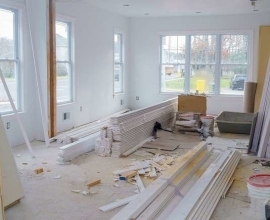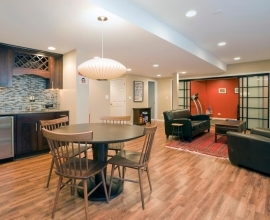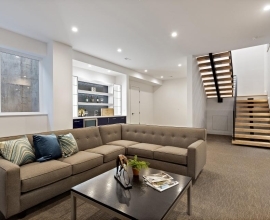How much does it cost to finish a basement?
Do you have an unfinished basement that you would love to convert into a cozy living space or play area for the kids? Creating a finished living space in your basement is a great way to add value to your home. In fact, you may see up to a 70 percent return on your investment. But there are several important things to consider before beginning your project.
What does “finished” mean to you?
How much does it cost to finish a basement?
Will you need to hire professional contractors?
Can you finance it?
We’ve covered the most important questions here to help you get started.
What is a finished basement?
It’s important to distinguish between what we typically consider finished and what general building codes consider finished.
When most of us think of a finished space we think of framing, insulation, drywall, ceilings and floors. But it’s not quite as simple as it sounds. There are many general building codes that specify requirements for finished space that may vary by location. These requirements specify room size, minimum ceiling height, required insulation ratings, flame spread rating on materials, stud spacing, ventilation, electrical outlet spacing and location, plumbing, etc. It is critical to understand these requirements or hire a professional who does.
Finished basement cost breakdown
We reviewed HomeAdvisor.com’s 2019 study to find the average cost of finishing a basement in the United States. Their study noted that costs vary greatly depending on geographical location, basement size and professional vs. DIY work. On average, the cost to finish a basement will range from $6,500 to $18,500.
To assess the cost of your own finished basement, you’ll need to consider the following cost categories. This isn’t intended to be all-inclusive. Your costs will vary.
Permits: These are required for home additions that include electrical and/or plumbing and usually cost around $50 per permit.
Contractors: Even if you plan to do some DIY work, you’ll need to hire licensed electricians and plumbers to ensure work is done to code. Licensed electricians charge $50 to $100 per hour, on average, according to HomeAdvisor. Licensed plumbers charge $45 to $200 per hour.
Framing: The cost of framing will depend heavily on the number of rooms your finished basement will have. Framing labor costs range from $2 to $12 per square foot.
Insulation: How much insulation will cost depends on what rating of insulation is used and whether you install it yourself or hire a professional.
Drywall and paint: It costs around $40 to $60 per panel for material and labor for drywall. Paint costs are an additional cost.
Flooring: Costs will vary greatly depending on whether you plan to finish the concrete, or use alternate flooring like carpet, hardwood, vinyl or laminate.
Waterproofing: Depending on the structure of your home, water leaks are a relevant consideration for any homeowner with a basement. Costs to waterproof your basement will vary depending on your home.
Fixtures and doors: This includes light fixtures, fans, hardware and doors. The costs will vary depending on what quality you purchase and who installs them.
How to plan your basement finishing project
1. Consider your comps
By comps, we mean home comparables in your area. It’s important to consider the other homes in your area and what people who move into that area are looking for. If you need help, consult with a local real estate agent who can give you details on your home’s comps. If you discover that finished basements are popular in your local area, that means you will likely see a nice return on the investment of finishing your basement. However, if you find that people in your area just aren’t looking for finished basements you may decide this isn’t the project for your home.
2. Define your finished basement goals
Whether it’s Google, Pinterest or recommendation from friends, do your research to determine your short- and long-term goals for the finished basement. Have a well-documented plan that outlines exactly what you want in a finished basement.
What will the space be used for?
What kind of design do you prefer?
What decorative style will be used for the space?
Will there be a bathroom that requires plumbing?
Will there be bedrooms?
Will there be a kitchen or kitchenette space?
3. Create a budget
How much can you afford to spend to finish your basement? Determine how much you can afford or are willing to spend and create a budget, broken down by the cost categories listed above. If you’re working with a general contractor, it will be important to discuss budget restrictions with them upfront.
4. Decide whether to hire a pro or do it yourself
While there may be some tasks you can do yourself, we recommend hiring a professional for the bulk of the basement renovation project.
Ask for recommendations: Be sure to ask people not to recommend a contractor they haven’t personally used.
Ask for estimates from more than one contractor: Be sure when comparing estimates you are comparing like estimates or apples-to-apples.
Ask for customer referrals with pictures: Contact those referrals and ask if their project was completed within the agreed-upon time and within the agreed-upon budget. Ask about the quality of work performed.
Check with local building department: Always check with your local building department to ensure the contractor you plan to hire is bonded, licensed and insured.
Tips to make a basement remodel cost-effective
Go for stylish but affordable
Consider selecting mid-grade materials that can be purchased as seconds or floor models for lower pricing. Think about the long-term use of the area and opt for less expensive options on things that will have no detrimental long term effect. For example, we don’t recommend trying to save money on poor-quality building materials, but we do recommend saving money by selecting the low to mid-grade light fixtures, switch plates, etc.
DIY options
While for most people, we don’t recommend a fully DIY approach when finishing a basement, there may be smaller jobs that can be done by you to reduce the overall cost to remodel the basement. We’re referring to things like installing flooring, installing or countertops, or tiling a shower.
Enjoy the openness
Minimize the number of separate rooms in your finished basement, as that will greatly reduce your costs. By embracing an open floor plan and fewer walls, you will cut costs on framing, wiring, drywall and doors. This also allows you to be flexible with the way you use the basement space. Perhaps now you want a cozy hangout, but five years from now you might want a fitness room. Stay flexible and save money, too.
Track your budget
With a little research and assessment of how much you can afford, creating a budget is the easy part. The part that often gets neglected is tracking and sticking to that budget. Keep a log of all expenses associated with your basement finishing project and deduct those from your budget categories regularly. If you find that you’re about to overspend in one category, we recommend finding another category to deduct from, if possible, to avoid going over budget.
Basement remodel financing options
Even if you have the money available in savings to cover your basement remodel costs, you may want to check into financing options. There are a variety of loans, including home improvement loans that may help you finish your basement without depleting your emergency savings. Here are a few loan choices to discuss with your bank or lending institution.
Personal loans
Personal loans are very broad in terms of what they can be used for. Finishing a basement is the type of expenditure that a personal loan may work well for. The way a personal loan is structured mirrors any standard loan: once the loan closes you begin being charged interest immediately and will make your first principal and interest payment after one month. Personal loans pay a fixed amount that is distributed in a lump sum. Repayment terms are pretty flexible, allowing you to select a very short-term loan or a longer one if necessary. These loans typically range from 12 months to 60 months. There also may be origination or closing fees associated with this loan from your bank or lending institution.
Home equity loans
A home equity loan uses the equity in your home to borrow from while using the home as collateral. This is also referred to as a second mortgage and is often used for large expenditures, like finishing a basement. Payments and terms on a home equity loan are usually similar to that of any standard loan with a fixed interest rate.
Home equity line of credit
A home equity line of credit, or HELOC, uses the same concept as a regular home equity loan in that it allows you to borrow against the equity in your home while using the home as collateral. The biggest difference is the line of credit is open, or revolving, and is usually accompanied by a variable interest rate. Think of a home equity line of credit like a credit card with a certain credit limit. You can borrow against it and pay it back, but the line of credit will remain open so that you can borrow against it again. A HELOC can be a perfect solution for a large project, such as refinishing a basement, where costs may not be set in stone. However, use this type of loan with caution as it’s flexibility makes it easy to go over budget.
Source: https://bit.ly/3bwxBM8







